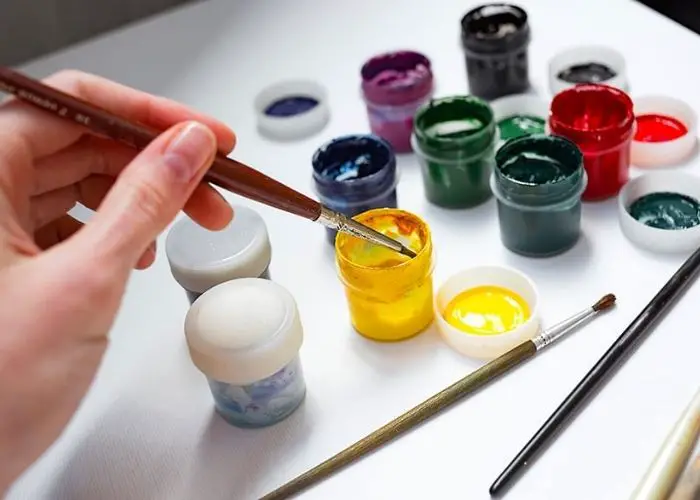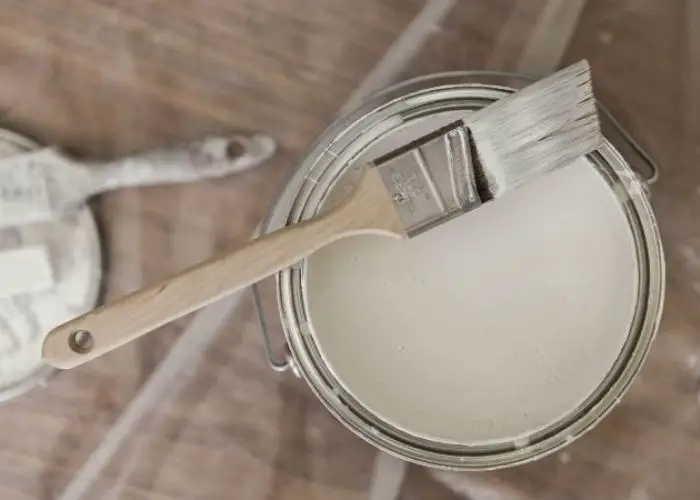It’s a question that comes up often among artists: can you mix acrylic and oil paint?
The answer is yes, you can mix these two types of paint together, but it’s not always advisable.
In this article, we’ll take a look at the different types of acrylic paints available on the market and how to use them for oils.
We’ll also explore what happens when you mix oil and acrylic paint and whether it’s better to use one type of paint over the other. So let’s get started!
Can You Mix Acrylic and Oil Paint?
It is not a good idea to mix these two types of paint together. The reason being is that they have different properties. For example, oil-based paints have a drying time of 24 to 48 hours, while acrylics can dry in as little as 15 minutes. This can cause problems if you’re not careful.
There are also differences in the way that each type of paint adheres to the surface.
For example, oil-based paints tend to ‘sink in’ more, while acrylics can create a ‘film’ on the surface. This can again lead to problems if you’re not careful.
Properties of Acrylic Paint

Acrylic paint is a synthetic polymer made from acrylic acid. It was first developed in the 1930s, and since then, it has become one of the most popular types of paint for artists.
Acrylic paint is known for its vibrant colors, fast drying time, and durability. It can be used on a variety of surfaces, including canvas, wood, and metal.
Additionally, acrylic paint is also water-soluble, meaning it can dissolve in water easily.
Types of Acrylic Paints
As we mentioned, there are different types of acrylic colors available.
Some are designed specifically for use with oil, while others can be used on their own or mixed with other acrylic gel medium.
The five different types of acrylic paints are heavy body acrylics, fluid acrylics, high flow acrylics, medium viscosity acrylics, and low viscosity acrylics.
Heavy body acrylics
Heavy body acrylics are a type of paint that is thick and creamy, making them perfect for creating textured effects.
They can be used straight from the tube or mixed with other mediums to create a variety of interesting effects.
Heavy body acrylics dry quickly and are extremely versatile, making them a favorite among artists of all levels.
One of the great things about heavy body acrylics is that they can be used on almost any surface, including canvas, wood, and even metal.
Fluid acrylics
Fluid acrylics are a thinner type of paint that is perfect for creating smooth, even layers of color.
They can be mixed with other acrylic mediums to create interesting effects or used on their own to create a variety of looks.
Fluid acrylics dry quickly and have high pigmentation, making them perfect for use on a variety of surfaces.
High flow acrylics
High-flow acrylics are a type of acrylic paint that is known for its thick consistency.
While this can be an advantage if you are looking to create textured effects or build up layers of color, it can also be difficult to control.
High-flow acrylics can also be more expensive than other types of acrylic paint.
However, they can be a good choice for experienced artists who are looking for a versatile medium.
Medium viscosity acrylics
Medium viscosity acrylics are a type of paint that is somewhere between fluid and heavy body acrylics in terms of consistency.
They can be used to create a variety of effects, from smooth layers of color to textured finishes.
Medium viscosity acrylics dry quickly and have good pigmentation, making them versatile for artists.
Low viscosity acrylics
Low viscosity acrylics are a type of paint that is thinner than fluid acrylics. They can be mixed with oil paint, but they will not mix well with thicker paints.
Low viscosity acrylics are good for painting thin layers of color or for glazing.
Can You Mix Oil and Acrylic Paint?

Now that we’ve covered the different types of acrylic paint, let’s answer the question: can you mix oil and acrylic paint?
The answer is yes, but there are a few things to keep in mind. One is that oil and acrylic paint have different drying times, just like mixing water and oil.
Acrylic paint dries quickly, while oil paint can take days or even weeks to dry. Luckily, there are different techniques on how to dry oil paint faster to streamline your creative process.
This means that if you mix oil and acrylic paint, the mixture will have a shorter drying time than either type of paint would have on its own.
Another thing to keep in mind is that oil and acrylic paint have different consistencies.
Acrylic paint is thinner than oil paint, so it can be difficult to control the amount of paint you are mixing.
This can lead to an uneven mixture, so it’s important to be careful when mixing these two types of paint.
How to Use Acrylic Paint for Oils
When it comes to mixing acrylic and oil paint, there are a few things you need to keep in mind.
First of all, oil and acrylic paint have different drying times. Acrylic paint dries quickly, while oil paint can take days or even weeks to dry.
This means that if you mix oil and acrylic paint, the mixture will have a shorter drying time than either type of paint would have on its own.
Another thing to keep in mind is that oil and acrylic paint have different consistencies.
Acrylic paint is thinner than oil paint, so it can be difficult to control the amount of paint you are mixing.
This can lead to an uneven mixture, so it’s important to be careful when mixing these two types of paint.
What Happens If You Mix Oil and Acrylic Paint?
If you mix oil and acrylic paint, the resulting mixture will have a shorter drying time than either type of paint would have on its own.
However, the consistency of the mixture will also be different from either type of paint, so it can be difficult to control the amount of paint you are mixing.
This can lead to an uneven mixture, so it’s important to be careful when mixing these two types of paint.
Can You Paint Oil Over Acrylic?
You can paint oils over acrylic, but there are a few things you need to keep in mind. One is that oil and acrylic paint have different drying times.
Acrylic paint dries quickly, while oil paint can take days or even weeks to dry.
This means that if you paint oil over acrylic, the mixture will have a shorter drying time than either type of paint would have on its own.
Another thing to keep in mind is that oil and acrylic paint have different consistencies.
Acrylic paint is thinner than oil paint, so it can be difficult to control the amount of paint you are mixing.
This can lead to an uneven mixture, so it’s important to be careful when mixing these two types of paint.
Can You Paint Acrylic Over Oil Paint?
No, you cant paint acrylics over oil but you can use oil paint over acrylics. Here are a few things you need to keep in mind.
Acrylics are fast-drying, so you’ll need to work quickly if you’re using them as a base layer.
Oil paints can take days or even weeks to dry, so you’ll need to be patient if you’re using them as a top layer.
There are also some differences in the way that oil and acrylic paints behave. Acrylics are water-based, so they can be thinned with water.
Oil paints are oil-based, so they can’t be thinned with water. Instead, you’ll need to use a solvent like mineral spirits or turpentine to thin oil paints.
One other thing to remember is that oil paint can yellow over time, so it’s not ideal for use in areas where you want a bright, white finish.
Acrylics can also yellow over time, but they’re less likely to do so than oil paints.
How to Make Acrylic Paint Look Like Oil
You can do a few things to make your acrylic paint look like oil paint. One is to use a glazing medium.
This clear, liquid medium can be added to your paint to give it a translucent quality. You can also add flow improvers to your paint.
These are substances that help the paint flow more smoothly and evenly. You can also add oil paint to your acrylic paint to create a more oil-like consistency.
Additionally, you can use slow drying acrylics to reduce the drying time of your paint.
Is It Better to Use Oil or Acrylic Paint?
There’s no easy answer to this question. It depends on what you’re trying to achieve.
If you’re looking for fast-drying paint that can be thinned with water, then acrylic is a good choice.
If you’re looking for a paint that has a slow drying time and can be thinned with a solvent, then oil is a good choice.
It’s also worth considering the finished look you’re going for. Oil paint can be yellow over time, so it’s not ideal for use in areas where you want a bright, white finish.
Acrylics can also yellow over time, but they’re less likely to do so than oil paints.
Can You Mix Water with Acrylic Paint?
Yes, you can mix water with acrylic paint. Acrylic paint is water-based, so it can be thinned with water.
However, you should be aware that adding too much water can make your paint runny and difficult to control.
Therefore, you should only add a small amount of water at a time until you achieve the desired consistency.
Can You Mix Water and Oil-based Paint?

No, you can’t mix oil paints with water-based paint. Oil-based paint is not water-soluble, so adding water will not thin it out.
In fact, adding water can make your paint sticky and difficult to work with. If you want to thin oil-based paint, you’ll need to use a solvent like mineral spirits or turpentine.
However, adding too much of these solvents can make your paint runny, so you should only add a small amount at a time until you achieve the desired consistency.
Can You Mix Acrylics with Other Types of Paint?
Yes, you can mix acrylics with other types of paint. You can mix them with oil paint to create a faster-drying paint or mix them with water-based paint to create a more fluid paint.
You can also add flow improvers to your acrylic paint to help it flow more smoothly and evenly.
However, you should be aware that adding too much of these can make your paint runny.
You can also mix acrylic paint with epoxy resin. Readout for more.
Can You Mix Oils with Other Kinds of Paint?
Yes mixing oil paint with other types of paint is allowed as long as the other paint is also oil-based.
For example, you can mix oil paint with alkyd paint. Alkyd paint is made from synthetic resin and can be mixed with oil-based paints and thinners.
You can also mix oil paint with enamel paint. Enamel paint is made from petroleum-based resin and can be mixed with other oil-based paints.
However, you should not mix oil paint with water-based paints, as the two types of paint will not mix well together.
Can You Paint Oil Paint Over Latex?
You can paint oil-based paint over latex paint, but you will need to use a primer first. Oil-based paint won’t adhere well to latex paint, so the primer will help it stick.
You can also add a flow improver to your oil-based paint to help it flow more smoothly and evenly.
However, you should be aware that adding too much of these can make your paint runny.
Can You Mix Acrylic and Latex Paint?
You can technically mix acrylic and latex paint, but it is not recommended. The two paints have different chemical compositions and will not bind together well.
The resulting paint job will be uneven and can easily peel off. If you absolutely must mix the two types of paint, be sure to use a ratio of three parts acrylic to one part latex.
Can You Paint Acrylic Over Enamel Paint?
Yes, you can paint acrylic over enamel, but you must use a primer first.
Enamel paint is very hard and glossy, so the acrylic paint will not be able to adhere to it properly without a primer.
You can either buy a special acrylic primer or just use a generic one. Be sure to sand the enamel paint before you start painting so that the primer can grip it better.
Painting Over Acrylic Paint on Wood
You can paint over acrylic paint on wood, but you must sand it first. Acrylic paint can be very difficult to remove once it dries.
You want to make sure that the wood is completely smooth before you start painting.
Once you’ve sanded the wood, you can either use a primer or just start painting with your chosen paint.
Just be sure to let the paint dry completely before you add any kind of topcoat.
How to Tell the Difference Between Oil and Acrylic Paintings
There are a few key differences between oil painting and acrylic painting. Oil paintings tend to have a more luminous quality, while acrylics can appear flatter.
Acrylics also dry much faster than oils, so you have to work quickly when using them.
Finally, oil paints can be blended together to create different effects, while acrylics will retain their original colors.
Knowing these key differences can help you choose the right type of paint for your project.
Can You Gesso Over Oil Paint
Yes, you can gesso over oil paint, but you will need to use a primer first.
Oil paint can be very difficult to remove once it dries, so you want to make sure that the surface is completely smooth before you start painting.
Then, once you’ve sanded the surface, you can either use a primer or just start painting with your chosen paint. Let the paint dry completely before you add any kind of topcoat.
Can You Use Acrylic Paint on Oil-based Primer?
You can use acrylic paint on oil-based primer, but you will need to thin the paint first.
Acrylic paint is thicker than oil-based primer, so it will not flow as smoothly. To thin the paint, add a few drops of water and mix well.
You can also add a flow improver to help the paint flow more smoothly. Once you’ve thinned the paint, you can start painting your surface.
FAQs
Can you add olive oil to acrylic paint?
No, you should not add olive oil to acrylic paint. Olive oil can change the consistency of the paint and make it difficult to work with. It can also yellow over time, which can affect the final color of your painting.
Can you put oil based poly over acrylic paint?
There are a few things to consider when deciding if you can put oil based poly over acrylic paint. Acrylic paint is water based, and oil based poly is a solvent. When you combine acrylic with oil poly, they could create a reaction that will damage the paint’s surface. Additionally, the poly’s presence could impede the paint’s adhesion to the surface, which could lead to peeling or cracking down the road.
What happens if you put oil based paint over latex?
If you put oil-based paint over latex, the paint will not adhere properly and can easily peel off. The two paints have different chemical compositions and will not bind together well. The resulting paint job will be uneven and can easily peel off. If you absolutely must mix the two types of paint, be sure to use a ratio of three parts oil-based paint to one part latex.
Are oil paintings more valuable than acrylic?
There is no definitive answer to this question. Some people prefer oil paintings because they tend to have a more luminous quality, while others prefer acrylics because they can appear more flat. Ultimately, it comes down to personal preference.
Can you mix acrylic paint with vegetable oil?
yes, but the results may not be what you expect. The two liquids will not mix evenly, and the paint will eventually settle to the bottom of the container. The oil will also cause the paint to dry more slowly, making it difficult to achieve a smooth finish. In addition, the paint may become less vibrant and have a more “greasy” appearance.
Can you turn acrylic paint into oil paint?
no, you can’t. However, there are a few ways that you can mimic the look of oil paint with acrylics. Add a medium such as linseed oil to your acrylic paint that will slow down the drying time, giving you more time to work with the paint before it dries. However, you will not get the same results as oil paint.
Can You Paint Enamel Over Acrylic?
Yes, you can paint enamel over acrylic. The acrylic paint dries quickly and provides a good base for the oil-based enamel to adhere to. Ensure the acrylic layer is completely dry before applying the enamel. However, testing this on a small area is always recommended to ensure compatibility and desired results.
Conclusion
So, can you mix acrylic and oil paint? The answer is yes! Just be sure to use a primer first and sand the surface before you start painting.
Also, be aware of the key differences between oil and acrylic paintings so that you can choose the right type of paint for your project. Thanks for reading!











Leave a Reply